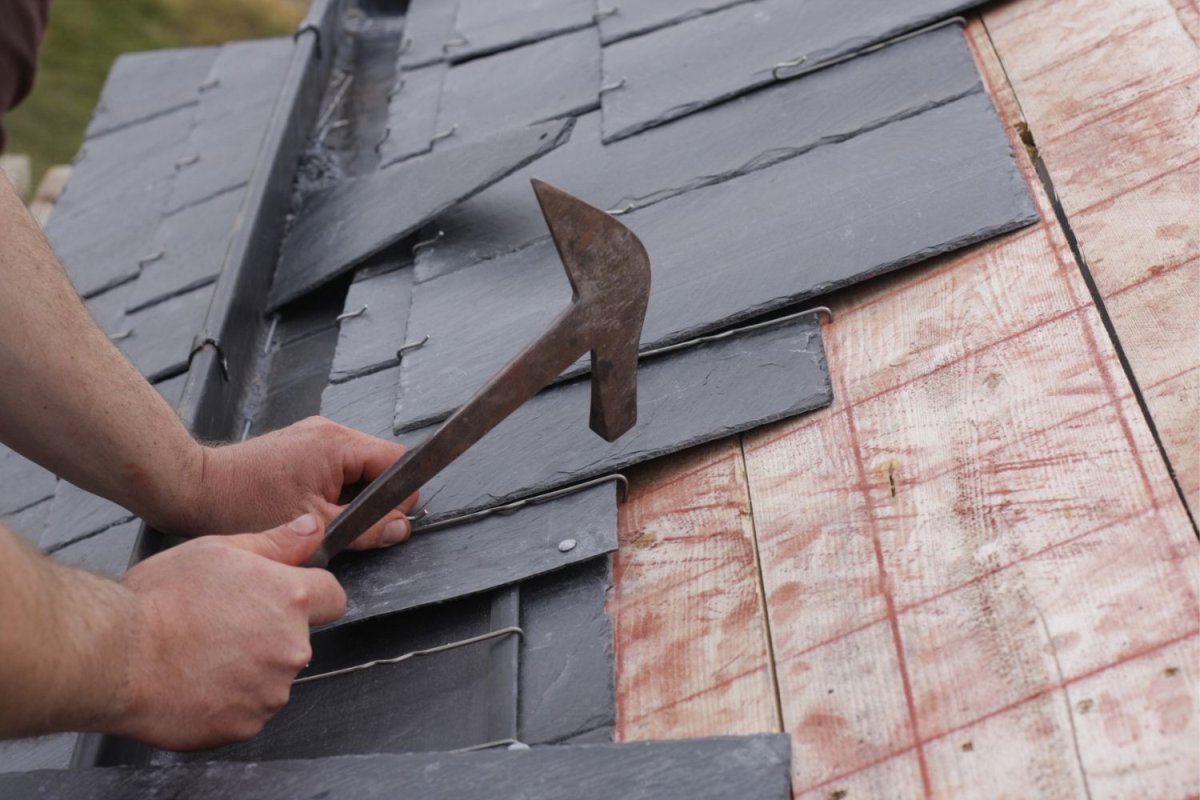

We may earn revenue from the products available on this page and participate in affiliate programs. Learn More ›
Highlights
- The typical cost range to install a slate roof is between $5,421 and $23,557, with the national average cost coming in at $13,926.
- The exact cost of a slate roof depends on several factors, such as the size, slope, pitch, and design of the roof; the type of slate; the cost of labor; and the slate manufacturer.
- A slate roof offers many benefits, including longevity, durability, energy efficiency, sustainability, easy maintenance, aesthetics, and return on investment.
- Roof installation is a difficult job that usually requires a professional roofer, and slate roof installation requires a professional who has experience working with this roofing material.
Slate roofs, made from fine-grained metamorphic rock, are renowned for their exceptional beauty and durability. With their distinctive appearance characterized by smooth, flat, and overlapping slabs of slate, these roofs add a touch of elegance to any architectural style. Homeowners opting for slate roofs enjoy a host of benefits that go beyond aesthetics. Slate roofs provide excellent protection against fire and extreme weather conditions and require minimal maintenance over their long lifespan.
According to Angi and HomeAdvisor, slate roof installation costs from $5,421 to $23,557, with a national average of approximately $13,926. Several elements influence these costs, including the size of the roof, the type of slate chosen, and local labor costs. This guide aims to delve deeper into the various factors that can impact slate roof cost, explore the different types of slate roofs, dig deeper into the benefits of a slate roof, and provide valuable insights on saving money and hiring a professional for this project.
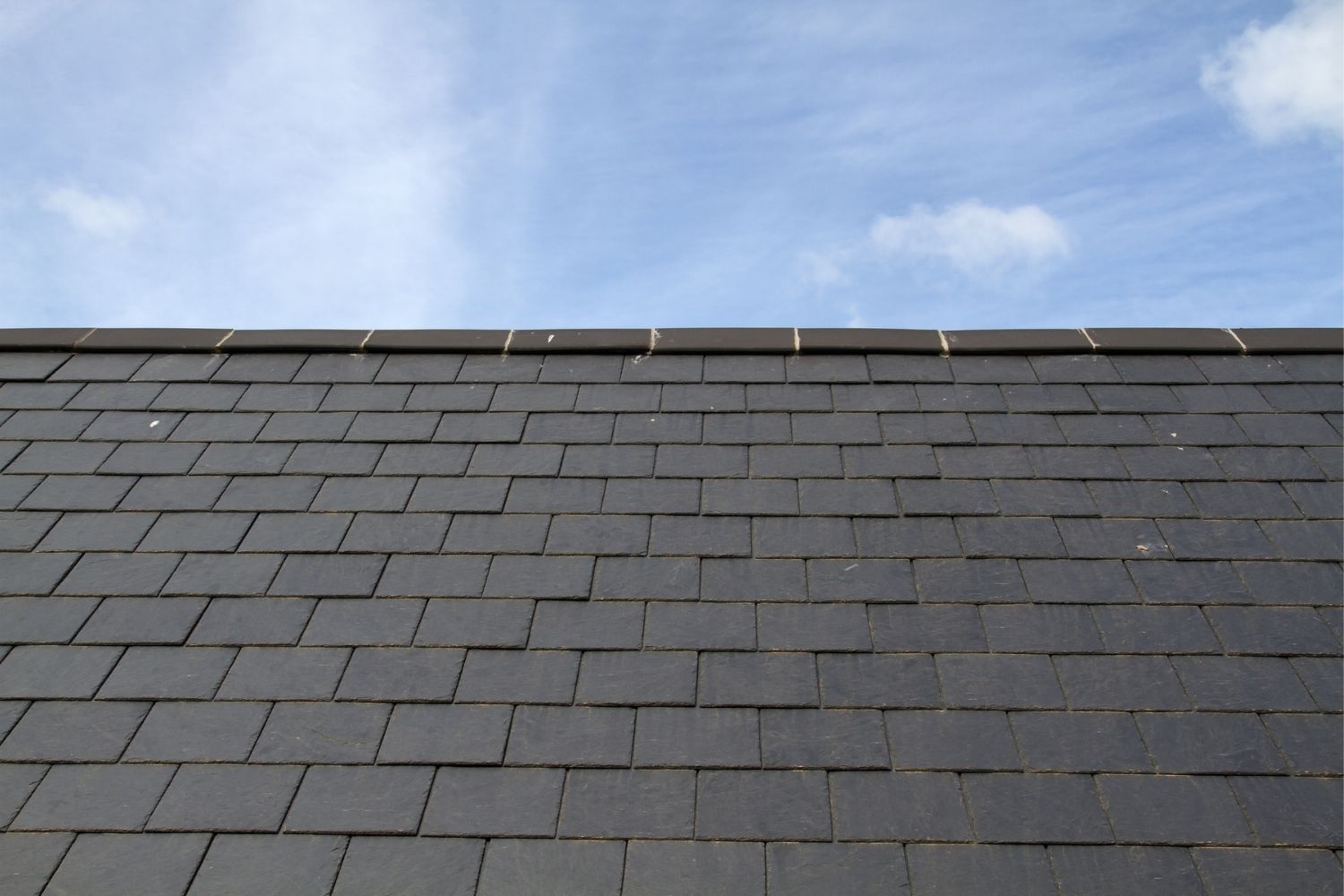
Factors in Calculating Slate Roof Cost
When it comes to estimating the cost of a slate roof, there are several factors that can come into play. Exploring these factors is essential for understanding the overall expenses involved. While national averages can provide a general idea, local variations can significantly impact the final costs. Homeowners will want to consider the following factors when estimating their slate roof cost.
Roof Size, Slope, and Pitch
The roof size is an important factor influencing the cost of installing a slate roof. Slate roofs are typically estimated and priced per square foot. The cost to purchase and install real slate roofs can range from $10 to $30 per square foot. Generally speaking, the larger the roof, the more it will cost to secure materials and installation.
In terms of slope and pitch, the steepness of a roof can impact the installation costs. Steeper roofs require additional safety measures and may require specialized equipment, resulting in higher labor costs. Roofs with pitches over 6:12, meaning they rise 6 inches for every 12 inches of horizontal distance, are generally more challenging to work on and often incur higher labor expenses due to the increased complexity of the installation process.
Roof Design
Roof design plays a significant role in determining the cost of installing a slate roof. Roofs with deep slopes, intricate designs, or other hazards can result in increased labor costs. Steeper slopes require additional safety measures and may require more time and effort to properly install the slate roofing tiles. Complex roof designs, such as multiple angles or irregular shapes, can also add to the complexity of the installation process and raise labor costs.
Furthermore, the presence of chimneys, skylights, or other roof elements that require new flashing can also contribute to increased expenses. Flashing installation involves ensuring a watertight seal around these areas, which may require additional materials and labor.
Slate Type
The type of slate chosen for a roof significantly influences the overall cost. Hard slate, renowned for its exceptional durability and longevity, tends to be the most expensive option. On the other hand, soft slate offers a more affordable alternative but may not last as long. Synthetic slate roofing costs are lower, and this slate alternative provides an attractive option, mimicking the aesthetic appeal of natural slate at a lower price point.
When selecting a slate type, homeowners will want to consider both their immediate budget and the long-term benefits. Investing in high-quality slate, such as hard slate, can result in a roof that stands the test of time, potentially saving money on future repairs and replacements.
The importance of long-term durability varies depending on individual circumstances. For homeowners planning to sell their property in the near future, selecting a slate type that enhances the home’s value and appearance can be beneficial. Conversely, for those intending to stay in their home for an extended period, prioritizing a slate type with extended longevity becomes more crucial, as it can offer potential cost savings over the slate roof lifespan.
Labor
Labor is a significant cost factor in slate roof installation, often accounting for a substantial portion of the total expenses. Slate is a material that requires meticulous installation and demands a considerable amount of time and effort.
It can take around 10 to 12 hours of installation time per square (equal to 100 square feet) of slate, making it a labor-intensive process. For a standard-size home, the installation of a slate roof can easily equate to several hundred hours of labor. This extended installation time is in contrast to other roofing materials, such as asphalt, which typically takes much less time to install.
Therefore, homeowners will want to be aware that the labor-intensive nature of slate roofs can contribute significantly to the overall project costs.
Manufacturer
Choosing a slate roof manufacturer is an essential part of the process; the quality of materials, warranty coverage, and available style options can vary, and having this information can enable homeowners to make an informed decision based on their preferences and budget. There are three popular options to consider, as listed in the following table.
| Manufacturer | Price Range per Square Foot (Materials and Labor) |
| Inspire by Boral | $6 to $12 |
| DaVinci | $8 to $12 |
| Greenstone | $8 to $12 |
- Inspire by Boral offers synthetic slate tiles priced between $6 and $12 per square foot, inclusive of materials and labor. With a wide range of 31 available colors and a 50-year transferable manufacturer’s warranty, Inspire provides homeowners with a durable and aesthetically appealing option.
- DaVinci is another manufacturer offering slate shingles at a cost of $8 to $12 per square foot. Its slate tiles are a more affordable alternative to natural stone and are available in three different style options. Homeowners can enjoy the beauty of slate while keeping costs in check.
- Greenstone is known for its exceptional quality and longevity. Its materials are priced between $8 and $12 per square foot, and Greenstone offers a remarkable 100-year warranty. With Greenstone’s variety of natural slate colors and textures, homeowners can choose a roofing solution that combines durability and visual appeal.
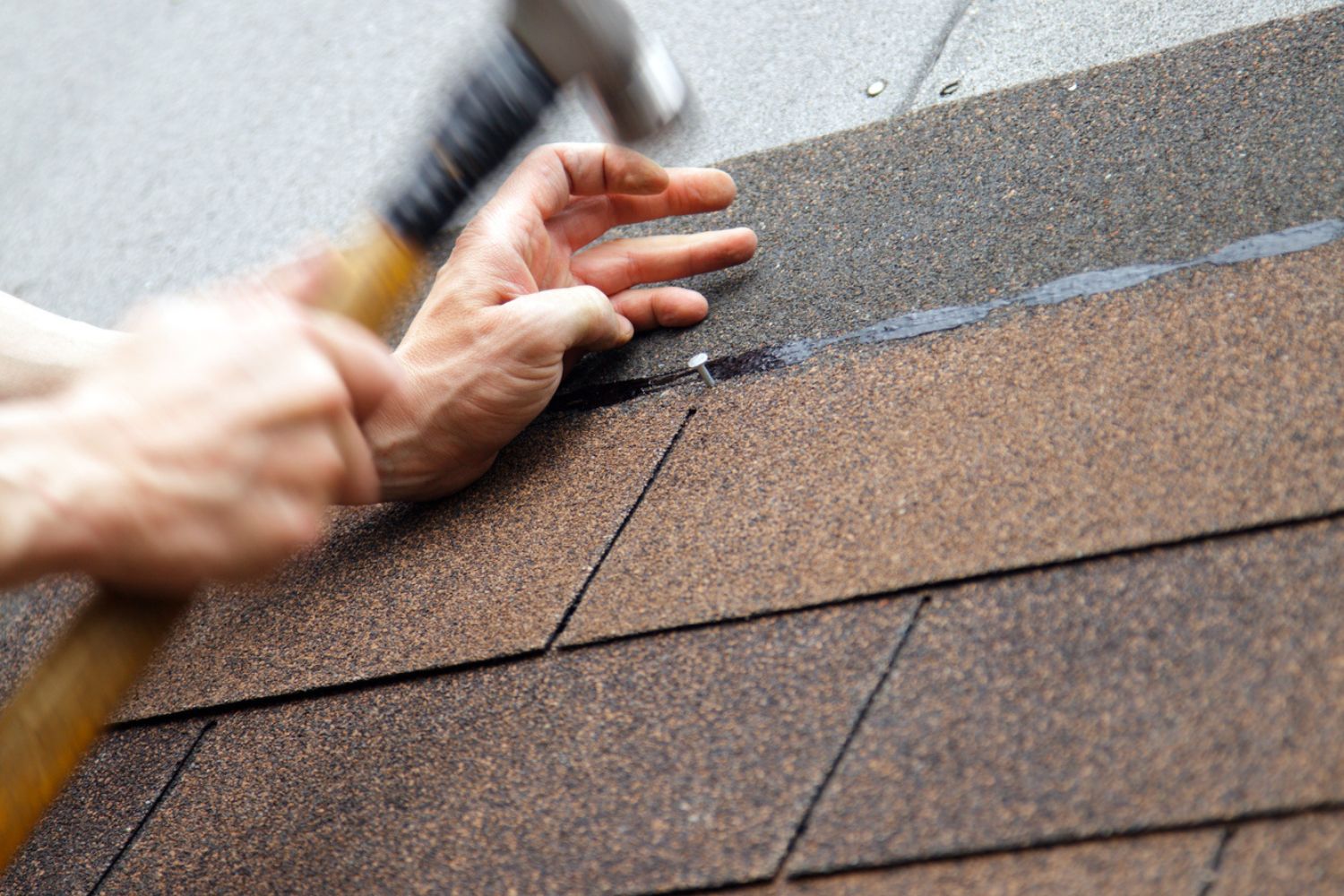
Additional Costs and Considerations
Not every situation mentioned in the following scenarios may happen during a slate roof installation, but homeowners should know about potential extra costs. Awareness of these considerations helps avoid unexpected expenses that can push an installation over budget.
Roof Inspection
A roof inspection can determine if there are any issues that could significantly impact the installation costs of a slate roof. If the inspection reveals underlying issues or the need for additional repairs, the costs of labor and materials associated with the installation can increase. For example, if the roof deck requires reinforcement or ventilation improvements are necessary, these additional tasks can add to the overall expenses.
A roof inspection costs between $120 and $321, depending on the size of the roof, location, and complexity of the inspection itself. Investing in a comprehensive roof inspection helps homeowners make informed decisions, proactively address potential problems, and obtain accurate cost estimates for their slate roof installation project.
Additionally, an annual roof inspection is an essential part of slate roof maintenance. Cracked or fallen slate tiles need to be replaced as soon as possible to prevent expensive water damage from occurring. An annual slate roof inspection by a professional slater costs an average of $350.
Old Roof Removal and Disposal
When replacing an old roof, there may be costs for homeowners to keep in mind associated with removing and disposing of the existing roofing materials. The total cost of old roof removal and disposal varies depending on the type of material. For example, removing an old slate roof costs between $2 and $5 per square foot, while removing asphalt or tile roofs comes in at a more affordable $1 to $3 per square foot.
If a homeowner takes the DIY approach and removes their own roof, the primary cost to consider is the dumpster rental for proper disposal. The cost to rent a dumpster for roof removal usually ranges from $280 to $500 per week. However, it’s important for homeowners to note that DIY roof removal requires careful planning, expertise, and adherence to safety precautions.
Alternatively, hiring professional contractors ensures a smoother and more efficient process. Professional roofers possess the necessary experience, tools, and knowledge to handle roof removal and disposal effectively.
Roof Reinforcement
During a slate roof installation, reinforcement may be necessary to ensure the existing roof structure can support the weight of the slate tiles. This is especially important if the roof was originally designed for lighter roofing materials. Reinforcement typically involves assessing the roof’s load-bearing capacity and making any necessary adjustments to provide adequate support.
Hiring a structural engineer is crucial to determine if roof reinforcement is needed. The cost for such expertise ranges between $100 and $220 per hour. It’s important for homeowners to note that this cost only covers the diagnosis and recommendations. The actual cost of the reinforcement work will depend on the extent of the required modifications and the specific requirements of the roof.
Underlayment Repair or Replacement
Synthetic or rubber slate roofing underlayment typically ranges from $0.10 to $0.90 per square foot, excluding labor expenses. Underlayment plays a crucial role in a slate roof, providing essential moisture protection and insulation. Over time, underlayment may require attention due to wear, tear, or aging. Repairing underlayment can address specific issues such as tears, while complete replacement becomes necessary for extensively deteriorated or expired underlayment.
Addressing underlayment issues as soon as possible ensures a slate roof’s best performance and lifespan. By investing in the maintenance and integrity of underlayment, homeowners can rest easy knowing their roof is protected against potential moisture-related issues.
Rafter Replacement
Rafters are essential roof-structure components, providing vital support and stability. Over time, they may require replacement due to factors such as age, decay, water damage, or structural issues. Signs such as sagging rooflines, cracks in rafters, ceiling stains, or persistent structural problems may indicate the need for replacement.
Rafter replacement costs typically range from $5 to $14 per square foot, depending on the material weight and roof condition. Slate roof installations may require additional considerations due to the weight of the materials. It’s crucial for a homeowner to consult with a professional roofing contractor for accurate cost estimates and expert guidance.
Professional expertise is essential for rafter replacement, ensuring compliance with building codes and safety standards. Qualified contractors can assess the roof’s condition, offer recommendations, and help homeowners make informed decisions.
Soffits and Fascia Replacement
Soffits and fascia play crucial roles in a roof’s functionality and appearance. Soffits are located beneath the roof’s overhang and provide ventilation to prevent moisture buildup, while fascia is the vertical board that covers the ends of the rafters. Over time, harsh weather, pests, and general wear and tear can cause these components to break down. In order to maintain a roof’s integrity and prevent further damage, homeowners will want to look into replacement sooner than later.
The cost of soffits and fascia replacement can vary widely, typically ranging from $900 to $6,800. Factors such as the size of the roof, the materials chosen, and the extent of damage or necessary repairs will influence the specific cost within that range.
Snow Guard Installation
Snow guards are devices installed on sloped roofs to prevent large chunks of snow and ice from sliding off suddenly. They serve the important purpose of minimizing the risk of snow avalanches, which can be hazardous for people, property, and surrounding areas. Without snow guards, the accumulated snow can rapidly slide down, causing damage to gutters and landscaping or even posing a danger to individuals below.
The necessity of snow guards depends on various factors, such as the climate, roof slope, and architectural design. Regions with heavy snowfall and steeper roofs typically benefit from snow guards. However, their installation may not be essential in milder climates or for roofs having minimal slopes.
Snow guards range from $5 to $30 or more per guard, depending on the material, design, and quality. The number of guards required for a house depends on roof dimensions, slope, and potential snow load. Consulting with a professional can help a homeowner determine the optimal placement and quantity of snow guards for effective snow retention.
Maintenance
Maintenance is crucial for ensuring the longevity and performance of a slate roof. Regular roof inspections are highly recommended to identify any potential issues early on and prevent costly repairs. These inspections, typically performed annually, involve a thorough assessment of the roof’s condition, including checking for loose or damaged slate tiles, inspecting flashings, and evaluating the overall integrity of the roofing system. On average, a roof inspection for a slate roof costs around $350.
In addition to inspections, slate roofs may require specific maintenance tasks such as cleaning to remove debris and maintain their aesthetic appeal. Cleaning a slate roof typically involves gentle methods to avoid damaging the delicate slate tiles. Professional cleaning services for slate roofs may cost anywhere from $0.30 to $0.70 per square foot.
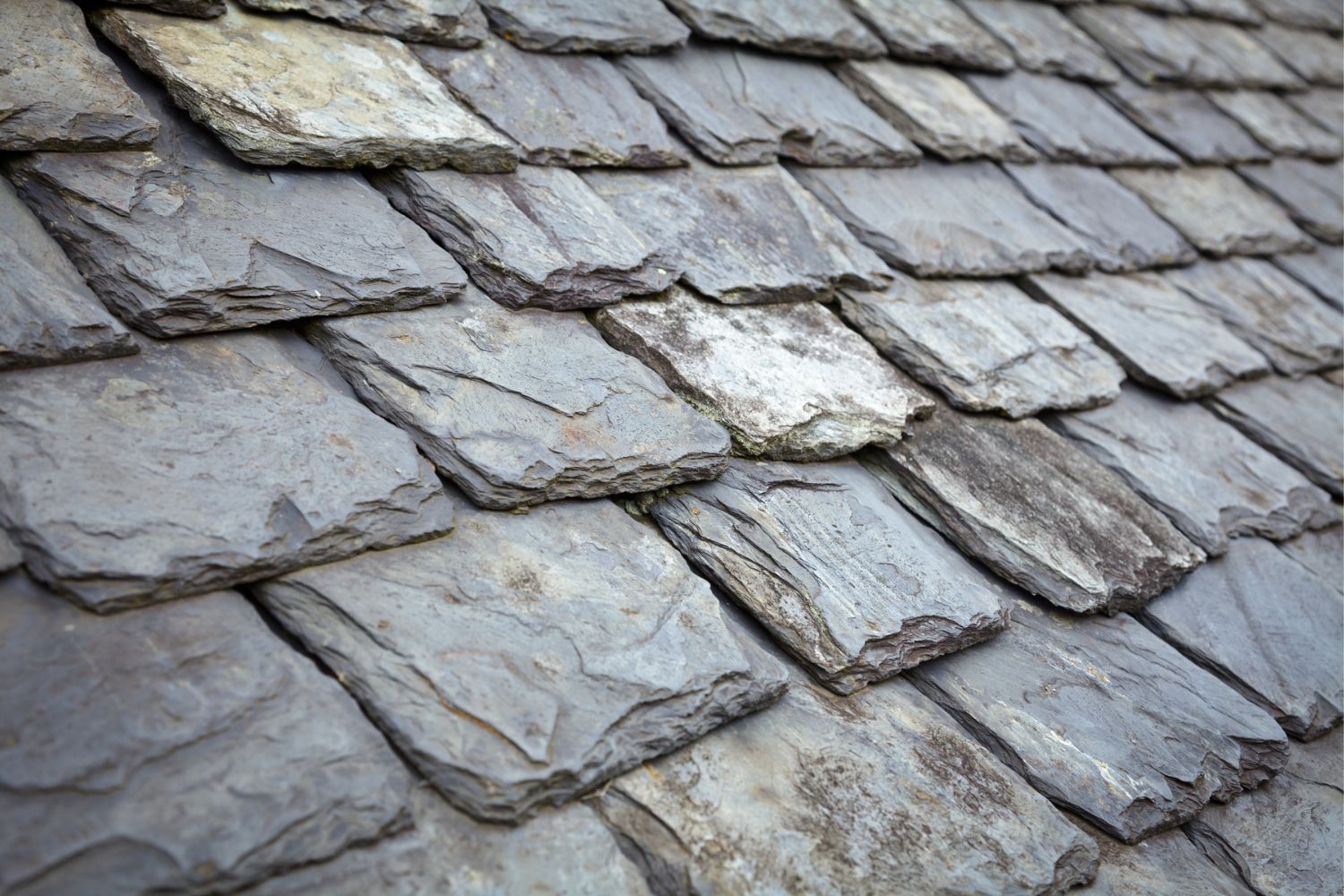
Types of Slate Roofs
Homeowners have multiple options when it comes to slate roofs, with each slate roof type having its own advantages and price points. Those preparing to install a slate roof can explore the most popular types below to find the one that is the best fit for their needs.
| Type of Slate Roof | Average Cost per Square Foot |
| Hard slate | $15 and up |
| Hybrid slate | $9 to $16 |
| Soft slate | $10 and up |
| Synthetic slate | $7 to $12 |
Hard Slate
Hard slate is a durable roofing material sourced from quarries. It is a dense and strong natural stone derived from sedimentary rock formations, making it ideal for long-lasting roofs.
With proper maintenance, hard slate roofs can endure for over a century. While hard slate offers excellent resistance to various weather conditions, including hail, snow, and rain, its standout feature lies in its remarkable strength. As the name implies, hard slate is the toughest natural slate variant available. Furthermore, hard slate boasts excellent insulating properties, contributing to enhanced energy efficiency in homes.
It is worth noting that hard slate’s superior quality and durability come at a higher price, typically costing $15 or more per square foot. However, the long lifespan and enduring performance of hard slate make it a worthwhile investment for those seeking a premium and resilient roofing option.
Hybrid Slate
Hybrid slate is a roofing option that combines the desirable qualities of a natural slate roof and synthetic materials. It is crafted using a blend of slate dust, resin, and fiberglass, creating a lightweight yet durable roofing material.
Hybrid slate replicates the aesthetic appeal of natural slate while providing enhanced resistance against weathering, impact, and fire. It’s a popular choice for homeowners looking for a cost-effective and practical substitute for more traditional slate types.
Hybrid slate prices range from $9 to $16 per square foot, making it an affordable solution that doesn’t compromise performance. As an added bonus, hybrid slate tends to be lighter than other varieties. Lighter roofing is easier to install, which can potentially save homeowners on labor costs as well.
Soft Slate
Soft slate is a budget-friendly and visually appealing roofing material, though it is less durable than hard slate. While it can be susceptible to cracking or breaking under heavy loads or impact, soft slate offers a cost-effective alternative to its harder counterpart.
Homeowners will want to be aware that soft slate may require extra maintenance and may have a slightly less uniform appearance with fewer color options. Nevertheless, it still provides longevity and excellent insulation qualities. With prices typically starting at around $10 per square foot, it presents an affordable choice for homeowners seeking a durable and attractive roofing solution.
Proper installation and regular maintenance can help ensure the optimal performance and lifespan of soft slate roofs.
Synthetic Slate
Synthetic slate roofing is an attractive and budget-friendly option, with prices ranging from $7 to $12 per square foot. This affordable alternative replicates the appearance of natural slate while offering additional advantages.
Composite slate roof tiles are lightweight, making them easier to handle and install compared to traditional slate. These tiles also require less structural support. Additionally, synthetic slate is resistant to cracking, fading, and weathering, ensuring long-lasting performance. It also provides excellent protection against fire, impact, and extreme temperatures.
With synthetic slate, homeowners can enjoy the aesthetic appeal of slate roofing without the high cost, while benefiting from its durability and low maintenance requirements.
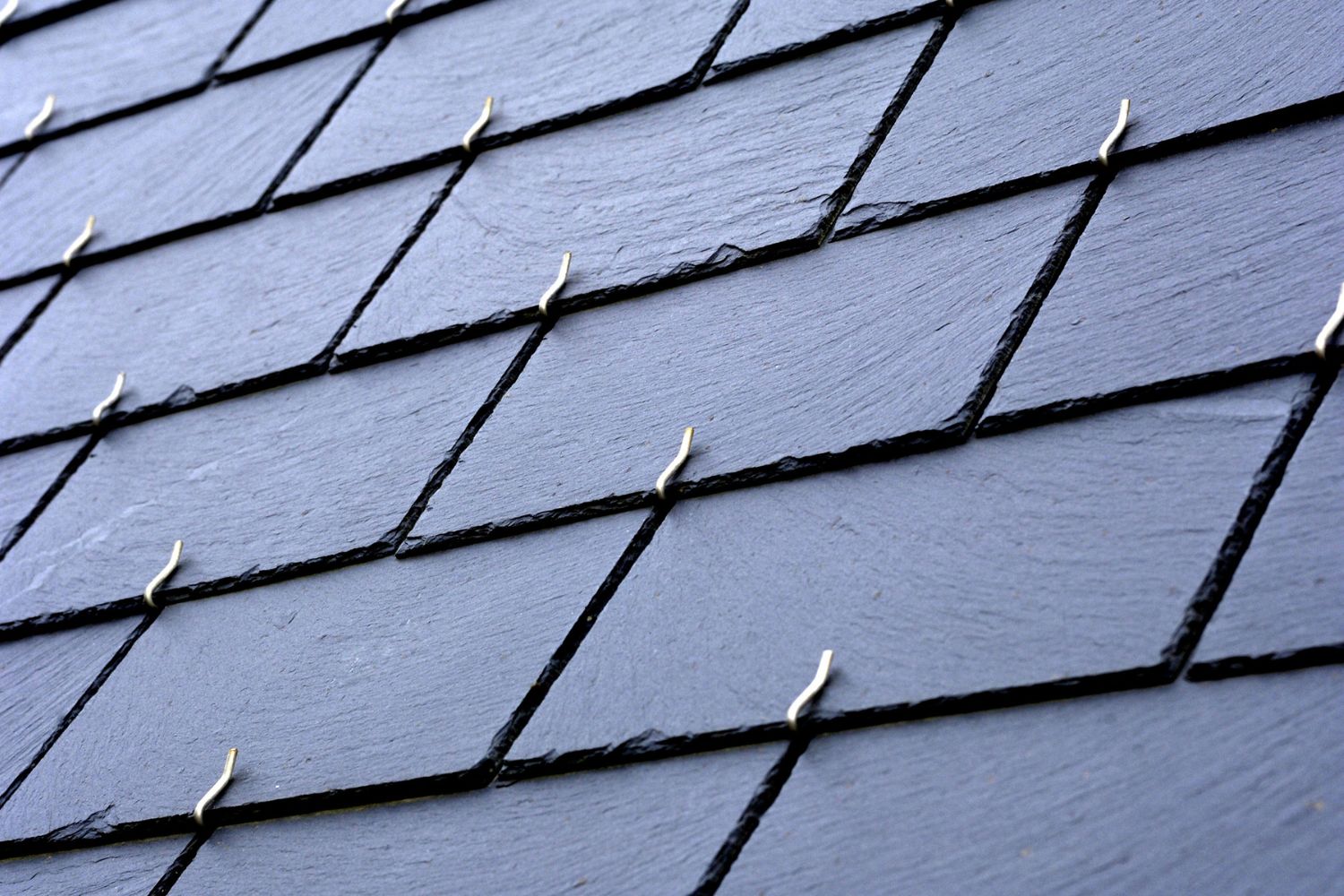
Benefits of Choosing a Slate Roof
A slate roof brings multiple benefits that greatly enhance a home’s appearance, functionality, and value. Homeowners will want to understand how a slate roof can positively impact these aspects. The various advantages of slate roofs are explored in more detail below.
Longevity
One of the significant benefits of a slate roof is its exceptional longevity. Slate, being a natural stone material, possesses remarkable durability and resistance to weathering. Its dense and nonporous nature prevents water absorption, making it highly resistant to freeze-thaw cycles that can cause cracking and deterioration in other roofing materials over time.
The longevity of a roof is crucial because it directly impacts a homeowner’s peace of mind and budget. A roof with a shorter lifespan may require frequent repairs or even a complete replacement, resulting in significant expense and inconvenience. In contrast, a slate roof’s extended lifespan ensures long-term reliability and minimizes the need for costly and disruptive maintenance or replacements.
Durability
Homeowners seeking long-lasting roofing solutions choose slate roofs for their exceptional durability. Slate roofs can last anywhere from 50 to 200 years, depending on the slate type and the installation quality. The material’s natural resistance to fire, rot, and pests further enhances its durability.
Selecting a durable roofing material is vital because it ensures reliable protection for the home. A less durable roof may experience a host of issues, such as frequent leaks, water damage, and compromised structural integrity. Homeowners could face the inconvenience and financial burden of frequent repairs or even roof replacement costs well before they might expect to if they choose a less expensive material. By opting for a durable slate roof, homeowners can enjoy the confidence of a resilient and long-lasting roofing solution.
Energy Efficiency
Slate roofs contribute to energy efficiency in several ways. To begin with, slate is a natural material known for its excellent insulation properties. By effectively insulating the home, slate roofs help retain warmth during winter and keep the interior cool during summer. This reduces a homeowner’s reliance on heating and cooling systems, ultimately leading to lower energy consumption and reduced utility bills.
In addition to its insulation capabilities, slate’s long-lasting nature minimizes the need for frequent maintenance and replacement. This aspect is crucial for sustainability, as it reduces the environmental impact associated with roof replacements and the disposal of roofing materials.
An energy-efficient roof offers significant benefits to homeowners. It promotes a comfortable indoor environment year-round, reduces reliance on energy-consuming systems, and offers long-term cost savings.
Sustainability
Slate roofs are an excellent choice for environmentally conscious homeowners because of their sustainability benefits. This material’s remarkable longevity ensures that the roof can withstand the test of time, reducing the need for frequent replacements and minimizing waste generation.
Additionally, slate is a recyclable material, allowing for its repurposing at the end of its lifespan, further reducing environmental impact. Furthermore, slate’s natural insulating properties contribute to energy efficiency, reducing reliance on artificial heating and cooling systems and lowering energy consumption. Slate roofs require minimal maintenance, reducing the need for chemical treatments and frequent repairs.
By opting for a sustainable slate roof, homeowners can embrace eco-friendly practices while enjoying the long-lasting and durable protection it provides to their homes. This benefits the environment and offers long-term cost savings, making it a wise investment for both the present and the future.
Low Maintenance
Due to their durability and long-lasting nature, slate roofs are generally low maintenance. The material’s resistance to weathering, fire, and insects eliminates the need for regular cleaning or painting.
Additionally, slate roofs are not prone to moss or algae growth, further reducing maintenance requirements. However, it’s important to note that repairing or replacing damaged slate tiles can be challenging.
A low-maintenance slate roof offers homeowners convenience and peace of mind, as it requires fewer time-consuming and costly maintenance tasks. This allows homeowners to focus on other aspects of homeownership while still enjoying the benefits of a beautiful and functional slate roof.
Aesthetics
Modern slate roofs are well known for their visual appeal and can significantly improve a property’s overall appearance and charm. A slate roof gives any structure a touch of elegance and character with its natural beauty, varied textures, and rich color variations.
Beyond personal preference, an aesthetically pleasing roof holds significance for homeowners in their daily lives, creating a sense of pride and enjoyment in their surroundings. Moreover, an attractive roof can significantly enhance a property’s curb appeal and market value, making it more appealing to potential buyers.
Slate roofs provide homeowners with the ideal combination of visual appeal and long-lasting durability, increasing both their living experience and the value of their property.
Return on Investment
Slate roofs provide homeowners with a significant return on investment over the long term. Despite the higher initial installation cost compared to other roofing materials, the durability and longevity of slate roofs make them a wise financial choice. With proper maintenance, a slate roof can last for a century or even more. This extended lifespan translates to potential savings on repair and replacement expenses over time.
Investing in a roof that offers a high return on investment is crucial as it ensures homeowners can enjoy the benefits of a durable and long-lasting roof while minimizing future financial burdens. By choosing a slate roof, homeowners make a prudent investment that can provide peace of mind and financial stability in the years to come.
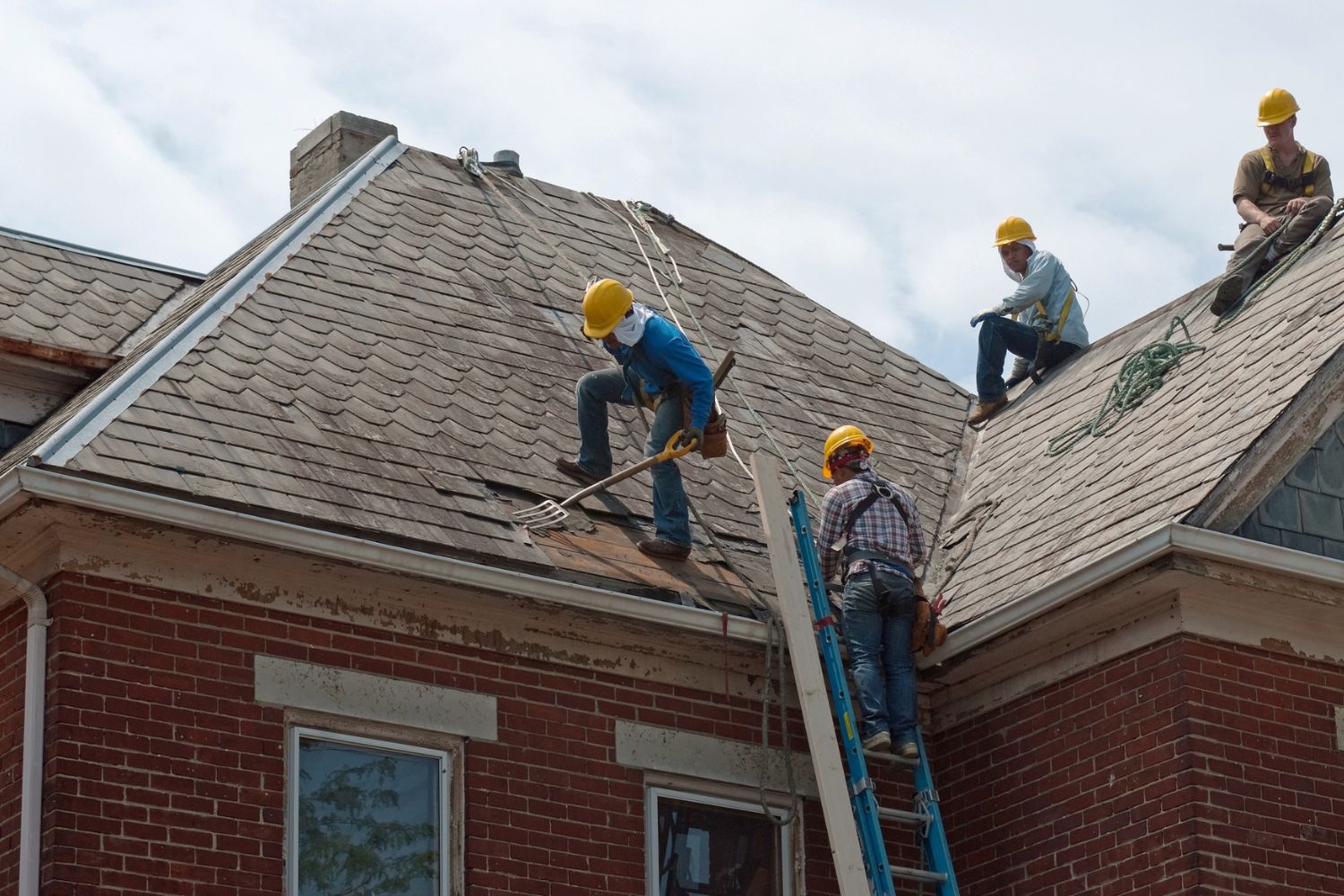
Slate Roof Installation: DIY vs. Hiring a Professional
Taking on a DIY slate roof installation may be tempting for the homeowner seeking cost savings and a thorough sense of accomplishment. While this approach offers certain benefits, it’s important to consider the complexity and potential risks involved in any roofing project. Below are several compelling reasons for why hiring a professional for slate roof installation is often the wisest choice.
- Safety. Roof installations, even those that appear straightforward, can be surprisingly dangerous. Homeowners who lack familiarity with the hazards of roof work may unwittingly put themselves in harm’s way, risking serious injury. Entrusting roof installations to professionals with expertise in navigating danger ensures the job is done safely.
- Quality. Proper slate roof installation requires specific techniques and knowledge of suitable materials. Professional roofers possess the skills and training to execute installations to the highest standards, ensuring the roof’s longevity, durability, and optimal performance over time.
- Warranty. Many slate roofing manufacturers stipulate that their warranties are valid only if the roof is installed by a licensed professional. Attempting a DIY installation or hiring an unlicensed contractor may void the warranty, leaving homeowners without the manufacturer’s support in the event of future issues or damage.
While the allure of cost savings may be appealing, a DIY slate roof installation can often end up costing more in the long run. The potential risks, compromised quality, and the loss of warranty protection associated with amateur installations can far outweigh any up-front savings.
When it comes to such a significant investment in a home’s structural integrity and value, it’s typically best for homeowners to entrust the job to nearby experienced roofing professionals. To find professionals in their area, homeowners can begin with an online search for “roofers near me.”
How to Save Money on Slate Roof Cost
While a slate roof can be a wise investment for homeowners, it’s important to be aware of the potential expenses involved. Fortunately, there are ways to save on slate roof costs. Consider the following money-saving tips.
- Shop around. Obtain quotes from multiple reputable slate-roofing contractors to compare prices.
- Go basic. Opt for standard-size slate tiles, which tend to be more cost-effective than custom sizes.
- Buy wholesale. Purchase slate tiles directly from suppliers or wholesalers to bypass retailer markups.
- Consider using recycled materials. Explore the option of purchasing salvaged or recycled slate tiles for a more affordable alternative.
- Check your insurance. In some cases, homeowners insurance covers roof repair or replacement. When replacing a roof after a storm or due to fire damage, see if any part of the expense is covered; this may be the time to consider upgrading to a slate roof.
- Stay simple. Choose a simpler slate roof design without intricate patterns or special features that can drive up costs.
- Stick with one color. Consider a single-color slate roof instead of a multicolored design, which can be more expensive.
- Hire in the off-season. Timing can be key; consider scheduling the installation during the off-season when contractors may offer discounted rates.
- Keep up with maintenance. After installation, properly maintain and care for the slate roof to prevent costly repairs or premature replacement.
- Consider a home warranty. Purchasing one of the best home warranties for roof coverage (such as American Home Shield or Choice Home Warranty) can offer additional protection if your roof needs to be repaired.
Questions to Ask About Slate Roof Installation
When having a slate roof installed, it’s important for homeowners to qualify their professional candidates to ensure they’re hiring the best roofing company for the job. Asking a series of purposeful questions helps homeowners assess the expertise and suitability of roofing professionals. The following questions can be asked by homeowners before, during, or after installation.
- What is a slate roof, and why should I consider it over another roofing material?
- Can you provide references or examples of past slate roof installations you’ve completed?
- How many years of experience do you have specifically with slate roofs?
- Are you licensed, insured, and bonded?
- Is my roof damage covered under my home warranty?
- Do you offer a warranty for the installation, and if so, what does it cover?
- Can you provide a detailed estimate that includes all expected costs?
- What type of slate would you recommend for my specific climate and home?
- How will you handle any necessary repairs or replacement of damaged slate tiles?
- Will you take care of obtaining the required permits for the installation?
- What is your estimated timeline for completing the installation?
- How do you ensure your crew’s and my property’s safety during the installation process?
FAQs
Slate roofs offer a range of benefits, including their timeless beauty, exceptional durability, and the potential to enhance the value of a home. To provide further clarity and insight, the following frequently asked questions address common concerns, offering valuable information to help homeowners make informed decisions about their slate roof installation.
Q. Is slate cheaper than roof tiles?
Slate roofs are renowned for their durability and timeless beauty. However, it’s worth noting that slate roof materials can be more expensive than other roofing materials. Despite the higher up-front cost, slate’s exceptional lifespan and low maintenance requirements make it a cost-effective choice in the long run. Its durability ensures fewer repair and replacement costs over time, potentially offsetting the initial investment.
Q. What are the disadvantages of a slate roof?
The initial cost of slate is higher compared to other roofing materials. Additionally, slate can be prone to cracks, and roof repair costs can be high. Due to its weight, slate may not be suitable for every home, as some structures may require additional reinforcement. Despite these factors, slate’s long-lasting nature and timeless beauty make it a preferred choice for many homeowners.
Q. How many years does a slate roof last?
The lifespan of a slate roof varies depending on the type of slate used. Synthetic slate roofs typically last between 20 to 50 years, while natural slate roofs can endure for an impressive 50 to 200 years. However, it’s important to note that achieving these long lifespans requires proper installation by experienced professionals.
Q. What’s better: synthetic slate or natural slate?
Natural slate offers superior strength, weather resistance, and longevity compared to synthetic slate. It requires less maintenance and is the more sustainable choice. However, synthetic slate is more cost-effective. While natural slate provides exceptional benefits if it fits within the budget, synthetic slate can be a viable alternative for those seeking a more affordable option.
Q. Does a slate roof add value?
Absolutely! A slate roof adds value to a home for several reasons. Its exceptional durability and long lifespan make it an attractive feature for potential buyers. Additionally, the aesthetic appeal of a slate roof, with its premium material and timeless charm, enhances the home’s overall appearance and curb appeal. These factors combined can significantly increase the value of a property.
Q. Is a slate roof worth it?
While the up-front cost of a slate roof is higher, it offers tremendous value in the long run. With proper maintenance, a natural slate roof can last for multiple generations, providing peace of mind and eliminating the need for premature roof replacements. The investment in a slate roof ensures durability, longevity, and the timeless beauty of premium roofing material.
Sources: Angi, HomeAdvisor, Fixr, HomeGuide
